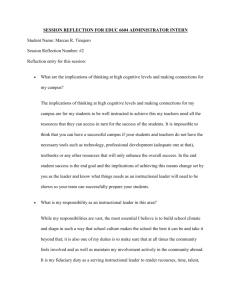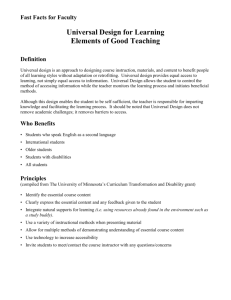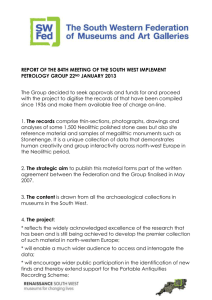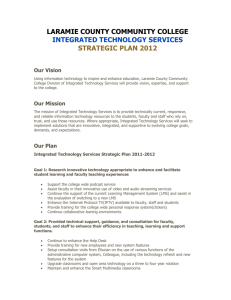Technology-Enhanced Learning Environments
advertisement
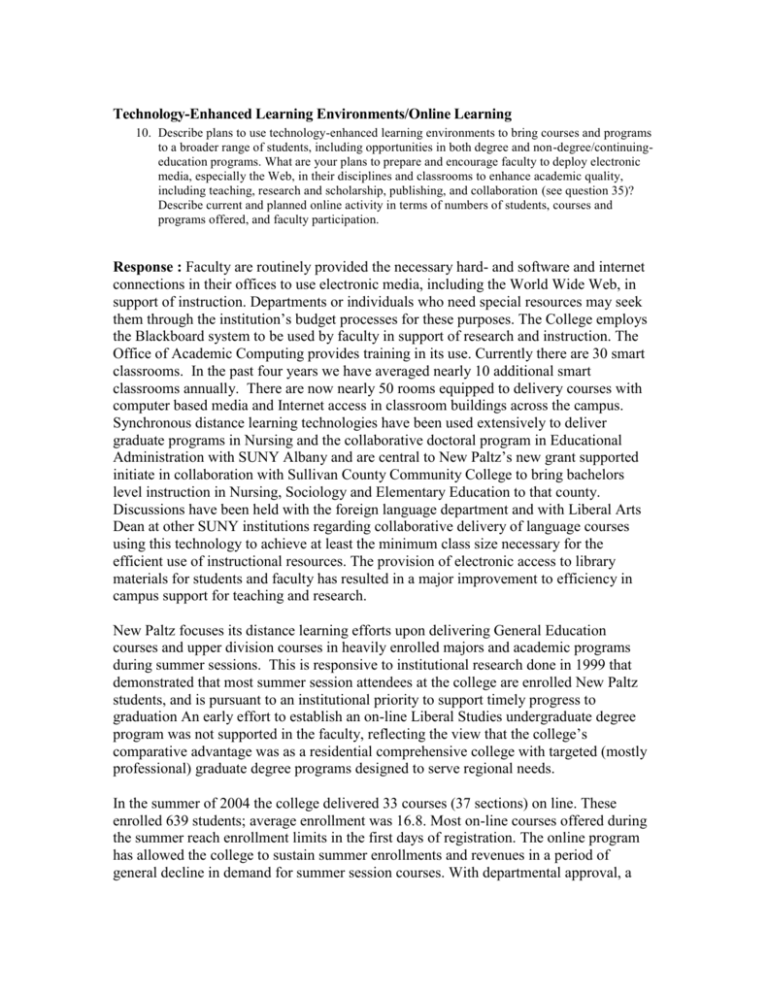
Technology-Enhanced Learning Environments/Online Learning 10. Describe plans to use technology-enhanced learning environments to bring courses and programs to a broader range of students, including opportunities in both degree and non-degree/continuingeducation programs. What are your plans to prepare and encourage faculty to deploy electronic media, especially the Web, in their disciplines and classrooms to enhance academic quality, including teaching, research and scholarship, publishing, and collaboration (see question 35)? Describe current and planned online activity in terms of numbers of students, courses and programs offered, and faculty participation. Response : Faculty are routinely provided the necessary hard- and software and internet connections in their offices to use electronic media, including the World Wide Web, in support of instruction. Departments or individuals who need special resources may seek them through the institution’s budget processes for these purposes. The College employs the Blackboard system to be used by faculty in support of research and instruction. The Office of Academic Computing provides training in its use. Currently there are 30 smart classrooms. In the past four years we have averaged nearly 10 additional smart classrooms annually. There are now nearly 50 rooms equipped to delivery courses with computer based media and Internet access in classroom buildings across the campus. Synchronous distance learning technologies have been used extensively to deliver graduate programs in Nursing and the collaborative doctoral program in Educational Administration with SUNY Albany and are central to New Paltz’s new grant supported initiate in collaboration with Sullivan County Community College to bring bachelors level instruction in Nursing, Sociology and Elementary Education to that county. Discussions have been held with the foreign language department and with Liberal Arts Dean at other SUNY institutions regarding collaborative delivery of language courses using this technology to achieve at least the minimum class size necessary for the efficient use of instructional resources. The provision of electronic access to library materials for students and faculty has resulted in a major improvement to efficiency in campus support for teaching and research. New Paltz focuses its distance learning efforts upon delivering General Education courses and upper division courses in heavily enrolled majors and academic programs during summer sessions. This is responsive to institutional research done in 1999 that demonstrated that most summer session attendees at the college are enrolled New Paltz students, and is pursuant to an institutional priority to support timely progress to graduation An early effort to establish an on-line Liberal Studies undergraduate degree program was not supported in the faculty, reflecting the view that the college’s comparative advantage was as a residential comprehensive college with targeted (mostly professional) graduate degree programs designed to serve regional needs. In the summer of 2004 the college delivered 33 courses (37 sections) on line. These enrolled 639 students; average enrollment was 16.8. Most on-line courses offered during the summer reach enrollment limits in the first days of registration. The online program has allowed the college to sustain summer enrollments and revenues in a period of general decline in demand for summer session courses. With departmental approval, a limited number of on-line courses is offered during the academic year as a part of fulltime faculty member’s regular teaching loads. In the 2003-2004 academic year there were 33 faculty members who taught on line at New Paltz. In the ten years between 1995 and 2004 a total of 66 faculty were trained for an offered on-line courses. The Dean of the College of Liberal Arts and Sciences, supported by The Associate Dean for Continuing Education and her staff, administers the on-line program for the institution. An annual call letter is issued every fall to seek faculty participation in on-line instruction. Courses must be approved for on-line offering through the institution’s curriculum approval process. Budget permits development support of 5 to 10 new on-line courses annually. A stipend of $3,000 is provided for the development of a first on-line course by a faculty member and $2,000 for a second course. Faculty are also provided the use of a lap top computer while they are teaching on-line. Colleagues who receive development stipends must teach their course at least three times. If courses are taught beyond three times, support is provided for a high-speed Internet connection at the faculty member’s home. Academic Computing, through the SUNY Learning Network, provides training and technical support. Technology (Plans for ensuring technology infrastructure supports academic quality) 34. Describe your planning process for ensuring that technology appropriately supports your mission, including relevant assessment processes. In addition, a. What is being done to ensure faculty and students have access to sufficient technology and training? Describe your plans for increased integration of technology in the classroom, including the proportion of instructional space that provides an instructor with network connectivity and projection capability, and the proportion of instructional space that provides network connectivity for each student seated in the classroom. b. What changes or investments in technology will be needed on campus by 2010 to support academic program directions, research, libraries, student support services, administrative initiatives, federal or state requirements, etc.? Describe the financial impact of these changes and how the initiatives will be funded. c. What new roles, responsibilities, and organizational changes have been implemented or are being considered to ensure that technology is adequately supported and integrated across the institution? d. How are you currently working with other campuses or organizations within SUNY to share technology resources and what opportunities do you envision for more collaborative efforts within the University? Response: Two years ago, Computer Services developed a strategic plan covering academic/instructional computing, administrative computing, and network services. The Central Committee on Educational Technology (a standing committee of the faculty), the college Cabinet and members of the campus at large reviewed the plan. The AVP for Technology meets with the CCET on a regular basis and two members of the professional support staff (one from academic computing and one from instructional media services) are members of the CCET. The campus is aggressively pursuing a schedule for introducing and maintaining classroom technology. This includes replacing classroom technology and computer labs on a regular basis and the introduction of additional smart classrooms every year. Approximately one-half of our classrooms are equipped with network connectivity and projection capability. The balance of our classrooms are served with mobile equipment. Classrooms equipped with individual student workstations number less than 10%. In addition, we have sophisticated, state of the art special purpose labs in many disciplines and the SCAP program is used to fund curricular-specific, faculty-initiated technology projects. We have adopted the Blackboard teaching and learning platform and automatically enroll every student and every course. Blackboard has been very successful and is heavily used across the curriculum. We have recently activated the ‘community space’ under Blackboard and now use the student records system to automatically create dozens of special purpose groups of students. In the coming years, we will be spreading network access, both wired and wireless, across the campus and into virtually every classroom. We will continue to improve the speed and resilience of our network infrastructure. This will support the anticipated increased reliance on technology as a means of delivery, and the anticipated increased need for bandwidth to support voice, video, and image repositories and digitized resources. These tasks require substantial funding to implement, and recurring funds, typically three years out, for replacement and upgrades. Thus far the majority of these projects have been funded through the Technology Fee, and we have had to increase this fee on a regular basis in order to continue to have the necessary funds to address our projects as well as to support the growing installed base of hardware, software and services. The campus’ reliance on key technology services has grown to the point where we are being asked to provide 24x7 support. This is putting a significant strain on our existing staff. In addition to an incremental increase in staff we will be relying on improvements in redundancy and remote monitoring capabilities to provide a more stable and recoverable environment. Over the past few years, the instructional media organization has become a part of the technology and information systems group. In addition, as the campuses technology resources continue to evolve, what was formerly ‘academic computing’ continues to reexamine and redefine its roles and responsibilities to address the changing environment. We are actively involved in COA, EdTOA, and the SUNY Council of CIOs. We are also a member of ITEC.
